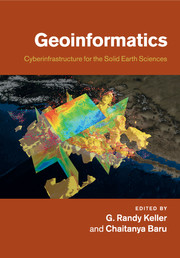Book contents
- Frontmatter
- Contents
- List of contributors
- Preface
- Introduction
- Part I Case studies from other disciplines
- Part II Modeling software and community codes
- Part III Visualization and data representation
- Part IV Knowledge management and data integration
- Part V Web services and scientific workflows
- 12 Service orientation in the design of a community hydrologic information system
- 13 Web services for seismic data archives
- 14 Development of robust data system for gravity and magnetic anomaly data: A case study of a community-based effort for point data
- 15 Scientific workflows for the geosciences: An emerging approach to building integrated data analysis systems
- 16 Online access and processing of LiDAR topography data
- 17 Use of abstraction to support geoscientists' understanding and production of scientific artifacts
- Part VI Emerging international and other efforts
- Index
- Plate section
- References
17 - Use of abstraction to support geoscientists' understanding and production of scientific artifacts
from Part V - Web services and scientific workflows
Published online by Cambridge University Press: 25 October 2011
- Frontmatter
- Contents
- List of contributors
- Preface
- Introduction
- Part I Case studies from other disciplines
- Part II Modeling software and community codes
- Part III Visualization and data representation
- Part IV Knowledge management and data integration
- Part V Web services and scientific workflows
- 12 Service orientation in the design of a community hydrologic information system
- 13 Web services for seismic data archives
- 14 Development of robust data system for gravity and magnetic anomaly data: A case study of a community-based effort for point data
- 15 Scientific workflows for the geosciences: An emerging approach to building integrated data analysis systems
- 16 Online access and processing of LiDAR topography data
- 17 Use of abstraction to support geoscientists' understanding and production of scientific artifacts
- Part VI Emerging international and other efforts
- Index
- Plate section
- References
Summary
Introduction
With advances in cyberinfrastructure (CI), scientists are able to solve more complex problems; in particular, CI assists in solutions that require collaboration, use of advanced instrumentation, discovery of knowledge resources, and distribution of work across a network of machines. The promise of CI is that it can impact scientific discovery and problem solving by providing the ability to access data collected from shared instruments, evaluate hypothesis by computationally intensive analysis, and retrieve results compiled by other scientists from around the world (Gil et al., 2007). Furthermore, CI-based techniques and methods support the integration, coordination, transformation, and visualization of data and other resources.
Because of the growing complexity of problems being solved by scientists with the use of CI, the use of abstraction is becoming more relevant in helping scientists work with complex processes. Abstraction is the notion of removing unnecessary details to support understanding. How information is viewed, i.e., the perspective of information, guides how abstraction can be used. For example, consider the description of an automobile. From the perspective of a valet, the color, make, and year of the automobile are sufficient to describe a car, and other details can be ignored; from the perspective of a mechanic, details about the engine are necessary. In addition, one can define different levels of abstraction by expanding the amount of detail presented, albeit the amount of detail included at any one level could vary depending on the need.
Information
- Type
- Chapter
- Information
- GeoinformaticsCyberinfrastructure for the Solid Earth Sciences, pp. 266 - 284Publisher: Cambridge University PressPrint publication year: 2011
